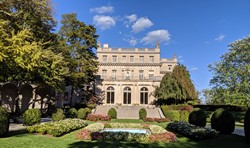The “Julian Abele Project,” a virtual exhibit that highlights Julian Abele, the African American leading architect of the Great Hall, was curated by students from the “Museums and Archives Management” history course in fall 2020. The exhibit features background on Abele, history of the Great Hall, an interview with Abele’s biographer, and more, which can be found as a LibGuide on the Monmouth University Library’s website.
“I’ve always wanted to do some type of project with my students on Julian Abele for a few years now,” said Melissa Ziobro, Specialist Professor of Public History who teaches the Museums and Archives Management course. “Over the past few years, the University has been revisiting its relationship with Woodrow Wilson and the renaming of Wilson Hall. In the course of those conversations, I learned about Julian Abele and his role in the building.”
Previously known as “Wilson Hall,” the University decided to rename its marquee building as “Great Hall at Shadow Lawn” in June 2020 in the wake of the Black Lives Matter movement, citing reasons that Woodrow Wilson promoted racism and discrimination during his presidency. The University also announced initiatives to honor Abele’s contributions as leading architect of the building.
“I’m a Monmouth alum myself and been on our campus since 2001, and I had never heard of him until really recently,” Ziobro said. “Everyone who has gone to Monmouth or even live in the area knows about the Great Hall but might think of it as where Annie was filmed, or they think of the Wilson connection because that was pushed for so long. But very few people have heard of Julian Abele who was this pioneering architect. We have to push that. That should be the thing that people think about with pride when they think about the Great Hall. Hopefully, our project will increase awareness about his role in it.”
“I didn’t know anything about Abele before the project, so being able to learn about him was interesting,” said Nicholas Testa, a history student who took part in the project. “[Abele] built a whole part of Duke University’s campus, had buildings in New York, and obviously the Great Hall on Monmouth’s campus. We were hoping to find as many buildings he had a connection to Abele as we could, and that could be found on the map portion of the LibGuide so people could get a more comprehensive look at what he built, where he bult it, and how big his scope was during his architectural career.” Abele is credited with over 200 buildings, according to the LibGuide.
“I’m glad to have contributed to something bigger,” Testa said. “I took part in preserving a part of the school’s history that very few people know about. Since Abele was so unknown to the school population, the fact that his legacy will live on is something that’s very important.”
Monmouth faculty were brought onto the project to peer review the material, with the University’s Geographic Information Systems (GIS) Program helping to create the map that highlights the locations of Abele’s buildings.
“The students and faculty were kind to include me, most specifically because of my participation in the campus discussions about Woodrow Wilson and his legacy a few years ago,” said Walter Greason Ph.D., Associate Professor and Chair of Educational Counseling and Leadership. “The project is tremendously important because it reverses decades of decision-making by university leadership to overlook African-American contributions to the educational mission here…the focus on Julian Abele moves our community forward in recognizing the unique ways that our university benefited from African-American leadership.”
 “What I teach my students is that historians never work in a vacuum,” Ziobro said. “You invite other scholars to come in and check your work. We made sure that this project upheld the highest standards of research practices, and that’s why we invited people like Dr. Greason to look at it. It was very important to us that this was not just some student project, but that it upheld normal scholarly processes.”
“What I teach my students is that historians never work in a vacuum,” Ziobro said. “You invite other scholars to come in and check your work. We made sure that this project upheld the highest standards of research practices, and that’s why we invited people like Dr. Greason to look at it. It was very important to us that this was not just some student project, but that it upheld normal scholarly processes.”
Ziobro’s Museums and History Management course is offered every other fall semester. Students have curated a World War I exhibit in 2016 and a Bruce Springsteen exhibit in 2018, which went on to become an exhibit at the Monmouth County Historical Association.
“Every time I teach this Museum and Archives class, the capstone project is an exhibit of some sort because I want the students to get hands-on practice in everything we’ve learned throughout the semester to better prepare them for life after Monmouth,” Ziobro explained. “It’s really meaningful for the students and for the campus community.”
Ziobro said that she will continue to push Monmouth’s mission to become a more inclusive campus by choosing research projects that shine a light on diversity. She said, “My current students are working on an oral histories of African Americans in Asbury Park and how they’ve been impacted disproportionally as a result of COVID-19. I am involved in another project of students of Dr. Walter McAfee, a pioneering African American scientist who also taught at Monmouth University.”
“In all of the projects we’re doing, we’re trying to be very thoughtful about telling inclusive stories and making sure that people know that Monmouth faculty care and ensuring that our work reflects that as well,” Ziobro said.
PHOTO TAKEN BY Melissa Badamo
IMAGE TAKEN from Duke University Website
IMAGES TAKEN from Monmouth University Library


